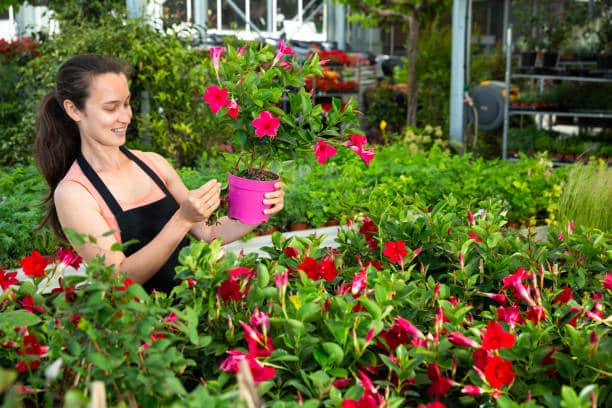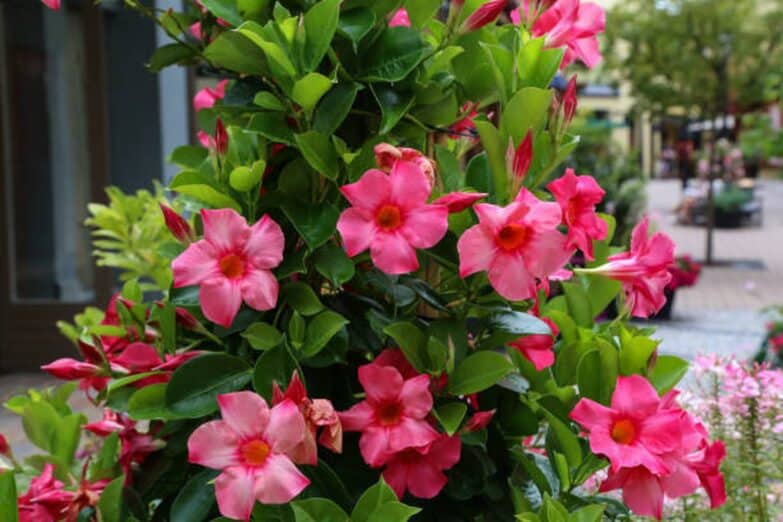Beloved for their beautiful, trumpet-shaped flowers and shiny, dark green foliage, Dipladenia plants are a popular choice for many gardeners and houseplant enthusiasts. Originally from South America, these tropical beauties can bring a touch of exotic charm to any home or garden. However, to keep them blooming and thriving, it’s essential to understand their unique care requirements. This article aims to provide an in-depth guide on how to care for your Dipladenia plant, ensuring it stays healthy and vibrant throughout the year.
Understanding Dipladenia: A Brief Overview
Before diving into the specifics of Dipladenia care, it’s helpful to know a little more about this plant. Dipladenia, also known as Mandevilla, is a genus of flowering vines that belongs to the Apocynaceae family. They are known for their glossy evergreen leaves and stunning flowers that come in various colors, including pink, white, and red. The flowers are usually trumpet-shaped, adding a distinctive, tropical feel to any setting.
While Dipladenia plants are native to tropical climates, they can be grown in cooler regions as indoor plants or annuals. These plants are perennial, meaning they can bloom for many years with the right care.
Basic Dipladenia Plant Care
Like any plant, Dipladenia has its own unique set of care requirements. Here are some of the essential factors you’ll need to consider:
Light Requirements
Dipladenias thrive in bright, indirect light. If you’re growing them outdoors, a spot that receives morning sun and afternoon shade would be ideal. For indoor plants, placing them near a south or east-facing window is typically sufficient. However, be careful not to expose them to too much direct sunlight, as this can cause the leaves to scorch.
Watering
When it comes to watering, Dipladenias prefer their soil to be consistently moist but never soggy. Overwatering can lead to root rot, a common plant disease that can be deadly if not addressed promptly. As a general rule, wait until the top inch of soil feels dry to the touch before watering your plant again.
Temperature and Humidity
Being tropical plants, Dipladenias enjoy warm temperatures and high humidity. They prefer temperatures between 60-80°F (15-27°C), but can tolerate slightly cooler conditions in winter. If temperatures drop below 50°F (10°C), it’s recommended to bring outdoor Dipladenias indoors.
As for humidity, misting the leaves with water can help increase humidity levels, especially for indoor plants. Alternatively, you could use a pebble tray filled with water or a humidifier to maintain the desired humidity.
Soil and Fertilizer
Dipladenias require well-draining soil to prevent waterlogging and root rot. A high-quality potting mix designed for use with tropical plants or flowering plants is usually a good choice. It’s also beneficial to add some organic matter, like compost or well-rotted manure, to improve the soil’s fertility and structure.
Regarding fertilizing, feed your Dipladenia with a balanced, water-soluble fertilizer every two weeks during the growing season (spring and summer). This will provide the necessary nutrients for robust growth and abundant flowering. However, reduce fertilizing in winter, as this is a period of slower growth for the plant.
Pruning and Repotting Your Dipladenia
Pruning
Pruning your Dipladenia plant can help maintain its size and shape, promote more vigorous growth, and improve its overall health. The best time to prune is in late winter or early spring, just before the new growth starts. Always use clean, sharp pruning shears to prevent the spread of diseases.
Repotting
Dipladenias typically need to be repotted every 2-3 years or when they outgrow their current pot. Choose a pot that’s one size larger than the previous one, ensuring it has ample drainage holes. When repotting, handle the root ball gently to avoid causing unnecessary stress to the plant.
Common Dipladenia Problems and Solutions
Pests
Like many houseplants, Dipladenias can be susceptible to common pests such as aphids, mealybugs, and spider mites. Regularly inspect your plant for signs of infestation, and if detected, treat with insecticidal soap or neem oil.
Diseases
Dipladenias can also be affected by a few diseases. Fungal diseases such as root rot can occur if the plant is waterlogged, while powdery mildew can appear if the plant is kept in a location with poor air circulation. If you notice any signs of disease, isolate the plant immediately to prevent the spread to other plants, and treat with a suitable fungicide.
Yellow Leaves
Yellow leaves can be a sign of several issues, such as overwatering, underwatering, nutrient deficiency, or even just natural aging. Check the plant’s care conditions to determine the cause and make the necessary adjustments.
Propagating Your Dipladenia
Dipladenias can be propagated through stem cuttings. The best time to take cuttings is in the spring. Use a sharp, clean knife to cut a stem that’s about 4-6 inches long, just below a leaf node. Remove the lower leaves, dip the cut end in rooting hormone, and plant it in a pot with well-draining soil. Keep the soil consistently moist and place the pot in a warm, bright location until new growth appears.
The Dipladenia’s Impact on Home and Garden

With their alluring flowers and lush foliage, Dipladenias make an excellent addition to any home or garden. They can be grown in pots, hanging baskets, or directly in the ground. Besides their aesthetic appeal, these plants can also attract pollinators like butterflies, enhancing biodiversity in your garden.
In a home setting, Dipladenias can bring a touch of tropical elegance to any room. They’re also known for their air-purifying qualities, helping to improve indoor air quality by removing certain pollutants.
Conclusion
The Dipladenia plant, with its gorgeous blooms and relatively easy care, is a great choice for both beginner and experienced gardeners. By providing the right conditions and promptly addressing any issues, you can enjoy this tropical beauty’s stunning display all year round. Whether you’re looking to add color to your garden or bring some greenery indoors, the Dipladenia can certainly rise to the occasion.

